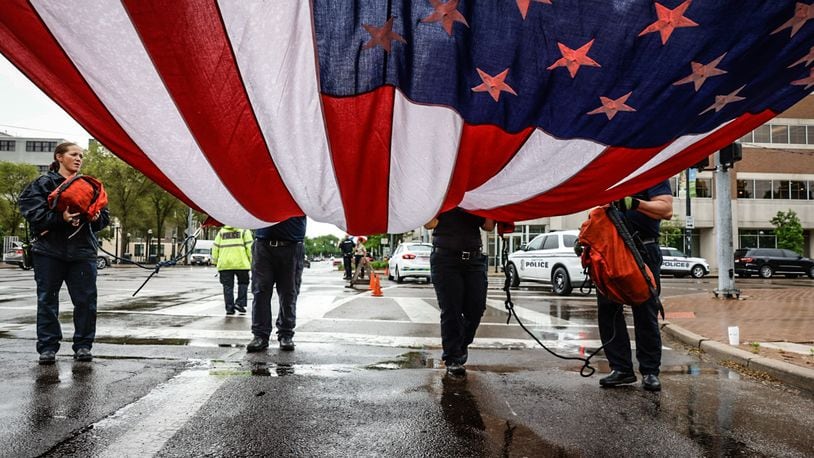First responders presented white flowers to the family members and representatives of their departments of nearly 50 Montgomery County police officers who died in the line of duty, dating back to 1880. Of those officers, 30 of them are from the Dayton Police Department.
Two new names were added to the list of commemorated officers: Germantown Police Assistant Chief Orion Hale, who died on duty in 1957, and University of Dayton police officer Anthony Cloyd, who died in December 2021.
Credit: Jim Noelker
Credit: Jim Noelker
“It’s about remembering heroes, how they lived their lives. It is not really about how they died, but about how they lived, living selflessly and protecting others and the community from harm,” said Dayton Police Chief Kamran Afzal.
Below 100
Cadets from the Sinclair Police Academy helped set up and tear down the event. Being in attendance reinforced a lesson they learned in the classroom: they are going into a dangerous profession, and they should do everything they can to make sure they and their fellow officers go home to their families every night.
For that reason, a class called “Below 100″ is required at the academy. “Below 100″ refers to the goal of law enforcement agencies across the country to reduce line of duty deaths to under a hundred officers per year, a statistic not seen since 1943.
The class teaches the main causes of line-of-duty deaths.
The number one cause of police officer deaths in the last five years is COVID-19, according to the National Law Enforcement Officers Memorial Fund. Between the start of 2020 and the end of 2023, 802 officers have died of COVID, accounting for more than half of all officer deaths in the last four years. By comparison, 541 officers were killed with a firearm in all of the last decade.
Credit: Jim Noelker
Credit: Jim Noelker
Discounting COVID, the top three causes of officer deaths in the last ten years are work-related illnesses (585), shootings (541), car crashes (292) and vehicle strikes (150), data from the National Law Enforcement Officers Memorial Fund shows.
Many of these deaths are preventable.
At Sinclair Police Academy, safety and vigilance are core themes that run through all training, not just Below 100, with everything from firearms and police vehicles, to being proactive about physical and mental health problems.
For example, many police officers don’t wear seatbelts, because the job requires them to constantly — and quickly — get in and out of their vehicles. Wearing safety vests, seatbelts, and being familiar with one’s equipment, are all small things officers can do to make it home safe at the end of the day.
“It takes two seconds,” instructor Randy Warren told cadets. “Wear your seat belt.”
Racing to the scene of a crime, engaging in a high-speed chase, are all regular incidents where officers are operating vehicles at high speeds. However, getting to the scene safely takes precedent over getting to the scene quickly.
“You all got into this profession to help people. You’re no good to those people if you’re dead or can’t get there,” Warren said. “I can stand up here and tell you ‘please don’t,’ but when the rubber hits the road, it’s up to you.”
‘The grief we feel’
Law enforcement agencies across the country paid tribute to officers during Law Enforcement Memorial Week last week.
Ohio Attorney General Dave Yost paid tribute Thursday to nine Ohio law enforcement officers who died in the line of duty between 2020 and 2023. Of the nine officers honored, six died of COVID. Two officers died in car accidents, and one died in the hospital after collapsing during a routine exercise.
During his remarks, Yost reflected on the deaths of four police officers in Charlotte, North Carolina, who were shot with a high-powered rifle while serving a warrant.
“The grief we feel for the peace officers honored here today is compounded by our shock at this tragic event,” Yost said. “The Thin Blue Line that connects our work — wherever that work is done — connects our hearts, too. And for that reason, we are gathered here not only to give comfort to each other, but to receive it.”
A story of survival
Speaking at Friday’s event in Dayton, retired officer Eric Ney, who served Clearcreek Twp., shared his story of survival after he was shot in the face on a call in 2022. Ney and his sergeant were dispatched to an active domestic violence incident on a farm on Route 48, in which a husband had driven a farm vehicle into his wife’s car, and was preventing her from leaving.
Credit: Jim Noelker
Credit: Jim Noelker
After taking statements from both parties, Ney and the sergeant attempted to arrest the man, at which point he pulled out a gun and shot Ney in the face just under his left eye.
Ney spent three months in the hospital, and said he remembers next to nothing of that time. He survived, but lost sight in his left eye, as well as his senses of smell and taste.
“I‘ve had more vegetables in the last two years than I have had my whole entire life,” Ney joked during his remarks at the ceremony.
Despite his ordeal, Ney said the process of healing deepened his Christian faith.
“I feel this is the best thing that ever happened to me. People don’t understand that,” Ney said. “I don’t remember my family, who spent the night every night with me, all the friends and visitors I had, the doctors and nurses that I had; I remember nothing except the Lord speaking with me those three months.”
| Year | Officer Deaths |
|---|---|
| 2018 | 187 |
| 2019 | 166 |
| 2020 | 428 |
| 2021 | 660 |
| 2022 | 266 |
| 2023 | 118 |
About the Author
